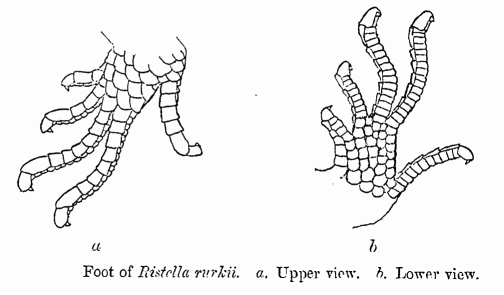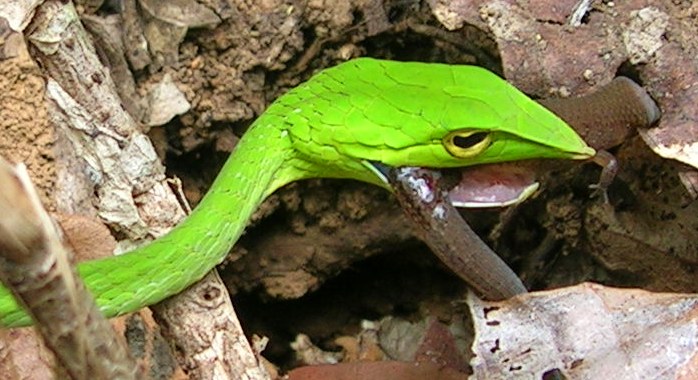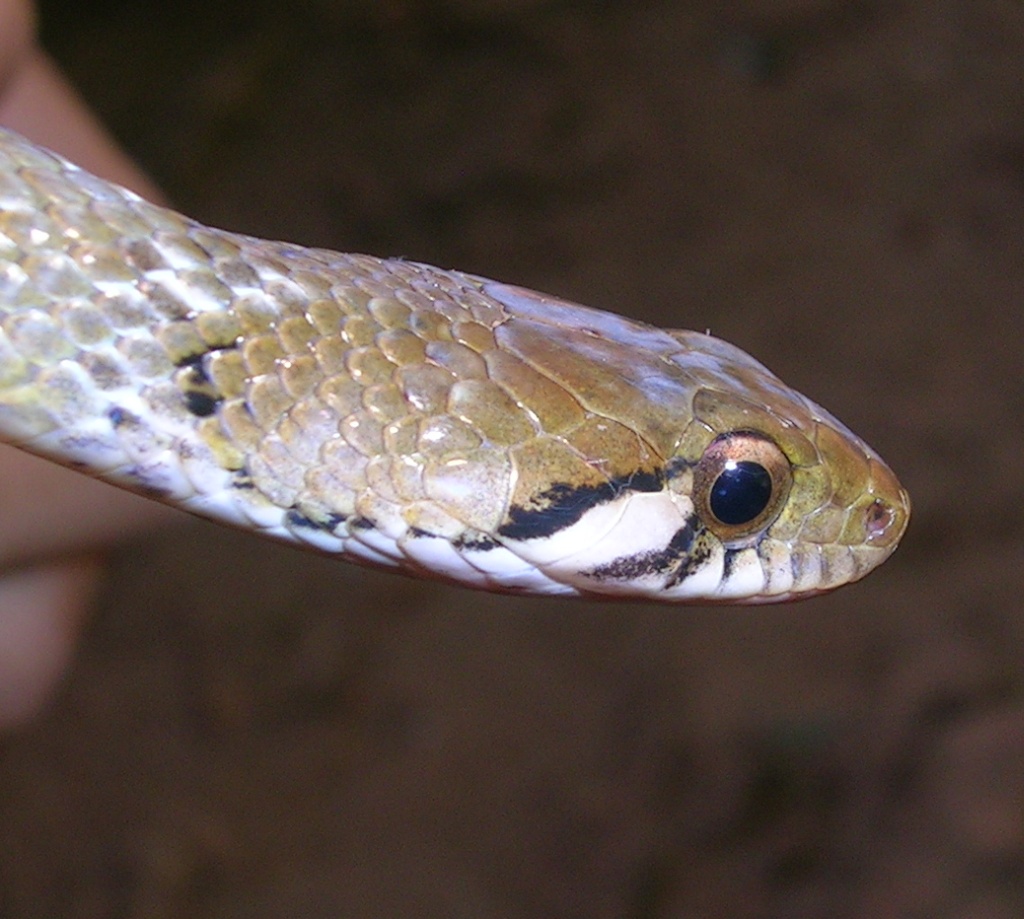|
Ristella
''Ristella'' is a genus of skinks endemic to the Western Ghats of southwestern India. They are commonly known as cat skinks because of their retractile claws. This genus can be instantly identified by the presence of only four fingers in forelimbs in all the species (instead of the usual five). All the members look more or less similar and are drab dark brown to blackish in complexion with paler undersides. This poorly known groups of lizards are diurnal, insectivorous, terrestrial to semi fossorial in habits. They inhabit deep leaf-litter and grasslands in montane forests and rainforests. Description Palatine and pterygoid bones in contact on the median line of the palate, which is toothless;palatine notch small, far behind, corresponding to the posterior notch of the tongue. Teeth conical. Eyelids well developed, scaly. Ear-opening distinct. Nostril pierced in a single nasal; no supranasals; prefrontals small or coalesced; frontoparietals and interparietal distinct. Limbs w ... [...More Info...] [...Related Items...] OR: [Wikipedia] [Google] [Baidu] |
Ristella Rurkii
''Ristella rurkii'', commonly known as Rurk's ristella, is a species of skink endemic to the Western Ghats of southern India. It is a small, insectivorous, diurnal skink found in shola grasslands and rainforests of hills ranges in parts of Tamil Nadu and Kerala states of India. Etymology The specific name, ''rurkii'', is in honor of "Dr. Rurk" who collected the type specimen.Beolens B, Watkins M, Grayson M (2011). ''The Eponym Dictionary of Reptiles''. Baltimore: Johns Hopkins University Press. xiii + 296 pp. . (''Ristella rurkii'', p. 229). Geographic range ''R. rurkii'' is found in South India, in the Anaimalai Hills, High Ranges, Travancore, and the Palni Hills, of Tamil Nadu and Kerala. It is endemic to rainforests south of Palghat Gap. References Further reading * Beddome RH (1870). "Descriptions of some new lizards from the Madras Presidency". ''Madras Monthly J. Med. Sci.'' 1: 30-35. (''Ateuchosaurus travancoricus'', new species, p. 33). * Boulenger GA (1887) ... [...More Info...] [...Related Items...] OR: [Wikipedia] [Google] [Baidu] |
Ristella Rurkii Gab Fbi
''Ristella'' is a genus of skinks endemic to the Western Ghats of southwestern India. They are commonly known as cat skinks because of their retractile claws. This genus can be instantly identified by the presence of only four fingers in forelimbs in all the species (instead of the usual five). All the members look more or less similar and are drab dark brown to blackish in complexion with paler undersides. This poorly known groups of lizards are diurnal, insectivorous, terrestrial to semi fossorial in habits. They inhabit deep leaf-litter and grasslands in montane forests and rainforests. Description Palatine and pterygoid bones in contact on the median line of the palate, which is toothless;palatine notch small, far behind, corresponding to the posterior notch of the tongue. Teeth conical. Eyelids well developed, scaly. Ear-opening distinct. Nostril pierced in a single nasal; no supranasals; prefrontals small or coalesced; frontoparietals and interparietal distinct. Limbs w ... [...More Info...] [...Related Items...] OR: [Wikipedia] [Google] [Baidu] |
Ristella Sp
''Ristella'' is a genus of skinks endemic to the Western Ghats of southwestern India. They are commonly known as cat skinks because of their retractile claws. This genus can be instantly identified by the presence of only four fingers in forelimbs in all the species (instead of the usual five). All the members look more or less similar and are drab dark brown to blackish in complexion with paler undersides. This poorly known groups of lizards are diurnal, insectivorous, terrestrial to semi fossorial in habits. They inhabit deep leaf-litter and grasslands in montane forests and rainforests. Description Palatine and pterygoid bones in contact on the median line of the palate, which is toothless;palatine notch small, far behind, corresponding to the posterior notch of the tongue. Teeth conical. Eyelids well developed, scaly. Ear-opening distinct. Nostril pierced in a single nasal; no supranasals; prefrontals small or coalesced; frontoparietals and interparietal distinct. Limbs w ... [...More Info...] [...Related Items...] OR: [Wikipedia] [Google] [Baidu] |
Ristella Travancorica
''Ristella travancorica'', commonly known as the Travancore cat skink or the Travancore ristella, is a species of skink endemic to the Western Ghats in India. Description Ear-opening not or but slightly larger than the nostril; third to sixth upper labials below the eye. Dorsal scales sharply bicarinate; 24, rarely 26, scales round the middle of the body. Otherwise as in ''R. rurkii''. Reddish brown above, each dorsal scale usually with a dark brown dot; usually a rather indistinct darker lateral band; lower surfaces uniform whitish. From snout to vent . Geographic range ''R. travancorica'' is found in India, in the Western Ghats, in the Ponmudi Hills (western Tamil Nadu state), and the Tirunelveli Hills (Kerala state). Das I. 2002. ''A Photographic Guide to Snakes and Other Reptiles of India''. Sanibel Island, Florida: Ralph Curtis Books. 144 pp. . (''Ristella travancoricus'', p. 113). Reproduction This species is oviparous. Egg laying coincides with the southwestern mons ... [...More Info...] [...Related Items...] OR: [Wikipedia] [Google] [Baidu] |
Ristella Beddomii
''Ristella beddomii'', commonly known as Beddome's cat skink and Beddome's ristella, is a species of skink, a lizard in the family Scincidae. The species is native to southwestern India. Etymology ''R. beddomii'' is named after Richard Henry Beddome (1830–1911), who was a British army officer and botanist. Description ''R. beddomii'' is a small species of skink, with a maximum snout-to-vent length (SVL) of . The ear-opening is larger than the nostril. There is a single azygos prefrontal, nearly as large as the frontonasal. The fourth to sixth upper labials are located below the eye. The body is much shorter than in the other species of the genus, and the adpressed limbs meet or slightly overlap. The dorsal scales are sharply bicarinate. There are 26 scales round the middle of the body. ''R. beddomii'' is reddish brown above, with or without 2 or 3 lighter dorsal streaks. The sides have scattered minute whitish dots. There is usually a black blotch with a few white dots above ... [...More Info...] [...Related Items...] OR: [Wikipedia] [Google] [Baidu] |
Ristella Guentheri
''Ristella guentheri'', commonly known as Günther's ristella and Gunther's cat skink, is a species of lizard in the family Scincidae. The species is endemic to India. Etymology The specific name, ''guentheri'', is in honor of German-British herpetologist Albert Günther. Beolens, Bo; Watkins, Michael; Grayson, Michael (2011). ''The Eponym Dictionary of Reptiles''. Baltimore: Johns Hopkins University Press. xiii + 296 pp. . (''Ristella guentheri'', pp. 110-111). Geographic range ''R. guentheri'' is found in India, in Madurai district, Tenmalai, Travancore, and the Anaimalai Hills. www.reptile-database.org. The type locality is "Madura, Sirimallay Hills" Boulenger GA (1887). ''Catalogue of the Lizards in the British Museum (Natural History). Second Edition. Volume III. Lacertidæ, Gerrhosauridæ, Scincidæ, Anelytropsidæ, Dibamidæ, Chamaeleontidæ.'' London: Trustees of the British Museum (Natural History). (Taylor and Francis, printers). xii + 575 pp. + Plates I- XL. (''Riste ... [...More Info...] [...Related Items...] OR: [Wikipedia] [Google] [Baidu] |
Richard Henry Beddome
Colonel Richard Henry Beddome (11 May 1830 – 23 February 1911) was a British military officer and naturalist in India, who became chief conservator of the Madras Forest Department. In the mid-19th century, he extensively surveyed several remote and then-unexplored hill ranges in Sri Lanka and south India, including those in the Eastern Ghats such as Yelandur, Kollegal, Shevaroy Hills, Yelagiri, Nallamala Hills, Visakhapatnam hills, and the Western Ghats such as Nilgiri hills, Anaimalai hills, Agasthyamalai Hills and Kudremukh. He described many species of plants, amphibians, and reptiles from southern India and Sri Lanka, and several species from this region described by others bear his name. Early life Richard was the eldest son of Richard Boswell Brandon Beddome, solicitor, of Clapham Common, S.W. He was educated at Charterhouse School and trained for the legal profession, but preferred to join the East India Company at the age of 18 and joined the 42nd Madras Native I ... [...More Info...] [...Related Items...] OR: [Wikipedia] [Google] [Baidu] |
Skinks
Skinks are lizards belonging to the family Scincidae, a family in the infraorder Scincomorpha. With more than 1,500 described species across 100 different taxonomic genera, the family Scincidae is one of the most diverse families of lizards. Skinks are characterized by their smaller legs in comparison to typical lizards and are found in different habitats except arctic and subarctic regions. Description Skinks look like lizards of the family Lacertidae (sometimes called ''true lizards''), but most species of skinks have no pronounced neck and relatively small legs. Several genera (e.g., ''Typhlosaurus'') have no limbs at all. This is not true for all skinks, however, as some species such as the red-eyed crocodile skink have a head that is very distinguished from the body. These lizards also have legs that are relatively small proportional to their body size. Skinks' skulls are covered by substantial bony scales, usually matching up in shape and size, while overlapping. Other gen ... [...More Info...] [...Related Items...] OR: [Wikipedia] [Google] [Baidu] |
Travancore
The Kingdom of Travancore ( /ˈtrævənkɔːr/), also known as the Kingdom of Thiruvithamkoor, was an Indian kingdom from c. 1729 until 1949. It was ruled by the Travancore Royal Family from Padmanabhapuram, and later Thiruvananthapuram. At its zenith, the kingdom covered most of the south of modern-day Kerala ( Idukki, Kottayam, Alappuzha, Pathanamthitta, Kollam, and Thiruvananthapuram districts, and some portions of Ernakulam district), and the southernmost part of modern-day Tamil Nadu (Kanyakumari district and some parts of Tenkasi district) with the Thachudaya Kaimal's enclave of Irinjalakuda Koodalmanikyam temple in the neighbouring Kingdom of Cochin. However Tangasseri area of Kollam city and Anchuthengu near Attingal in Thiruvananthapuram district, were British colonies and were part of the Malabar District until 30 June 1927, and Tirunelveli district from 1 July 1927 onwards. Travancore merged with the erstwhile princely state of Cochin to form Travancore-Cochin i ... [...More Info...] [...Related Items...] OR: [Wikipedia] [Google] [Baidu] |
Species
In biology, a species is the basic unit of classification and a taxonomic rank of an organism, as well as a unit of biodiversity. A species is often defined as the largest group of organisms in which any two individuals of the appropriate sexes or mating types can produce fertile offspring, typically by sexual reproduction. Other ways of defining species include their karyotype, DNA sequence, morphology, behaviour or ecological niche. In addition, paleontologists use the concept of the chronospecies since fossil reproduction cannot be examined. The most recent rigorous estimate for the total number of species of eukaryotes is between 8 and 8.7 million. However, only about 14% of these had been described by 2011. All species (except viruses) are given a two-part name, a "binomial". The first part of a binomial is the genus to which the species belongs. The second part is called the specific name or the specific epithet (in botanical nomenclature, also sometimes i ... [...More Info...] [...Related Items...] OR: [Wikipedia] [Google] [Baidu] |
Kanara
Kanara, also known as Karavali is the historically significant stretch of land situated by the southwestern coast of India, alongside the Arabian Sea in the present-day Indian state of Karnataka. The region comprises three civil districts, namely: Uttara Kannada, Udupi, and Dakshina Kannada. Etymology According to historian Severino da Silva, the ancient name for this region is ''Parashurama Srushti'' (creation of Parashurama). According to him and Stephen Fuchs, the name ''Canara'' is the invention of Portuguese, Dutch, and English people who visited the area for trade from the early sixteenth century onwards. The Bednore Dynasty, under whose rule this tract was at that time, was known to them as the Kannada Dynasty, i.e., the dynasty speaking the Kannada language. "Karāvalli", the Kannada word for 'coast', is the term used by Kannada-speakers to refer to this region. The letter 'd' being always pronounced like 'r' by the Europeans, the district was named by them as ... [...More Info...] [...Related Items...] OR: [Wikipedia] [Google] [Baidu] |
Coorg
Kodagu (also known by its former name Coorg) is an administrative district in the Karnataka state of India. Before 1956, it was an administratively separate Coorg State, at which point it was merged into an enlarged Mysore State. It occupies an area of in the Western Ghats of southwestern Karnataka. In 2001 its population was 548,561, 13.74% of which resided in the district's urban centre, making it the least populous of the 31 districts in Karnataka. The nearest railway stations are Mysore Junction, located around away, Thalassery, and Kannur, the latter two located in Kerala at a distance of about . The nearest airports are Kannur International Airport in Kerala ( from Madikeri) and Mangalore International Airport ( from Madikeri). Geography Kodagu is located on the eastern slopes of the Western Ghats. It has a geographical area of . The district is bordered by Dakshina Kannada district to the northwest, Hassan district to the north, Mysore district to the east, Kasa ... [...More Info...] [...Related Items...] OR: [Wikipedia] [Google] [Baidu] |






